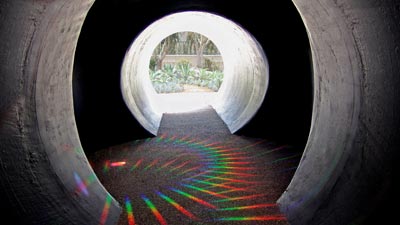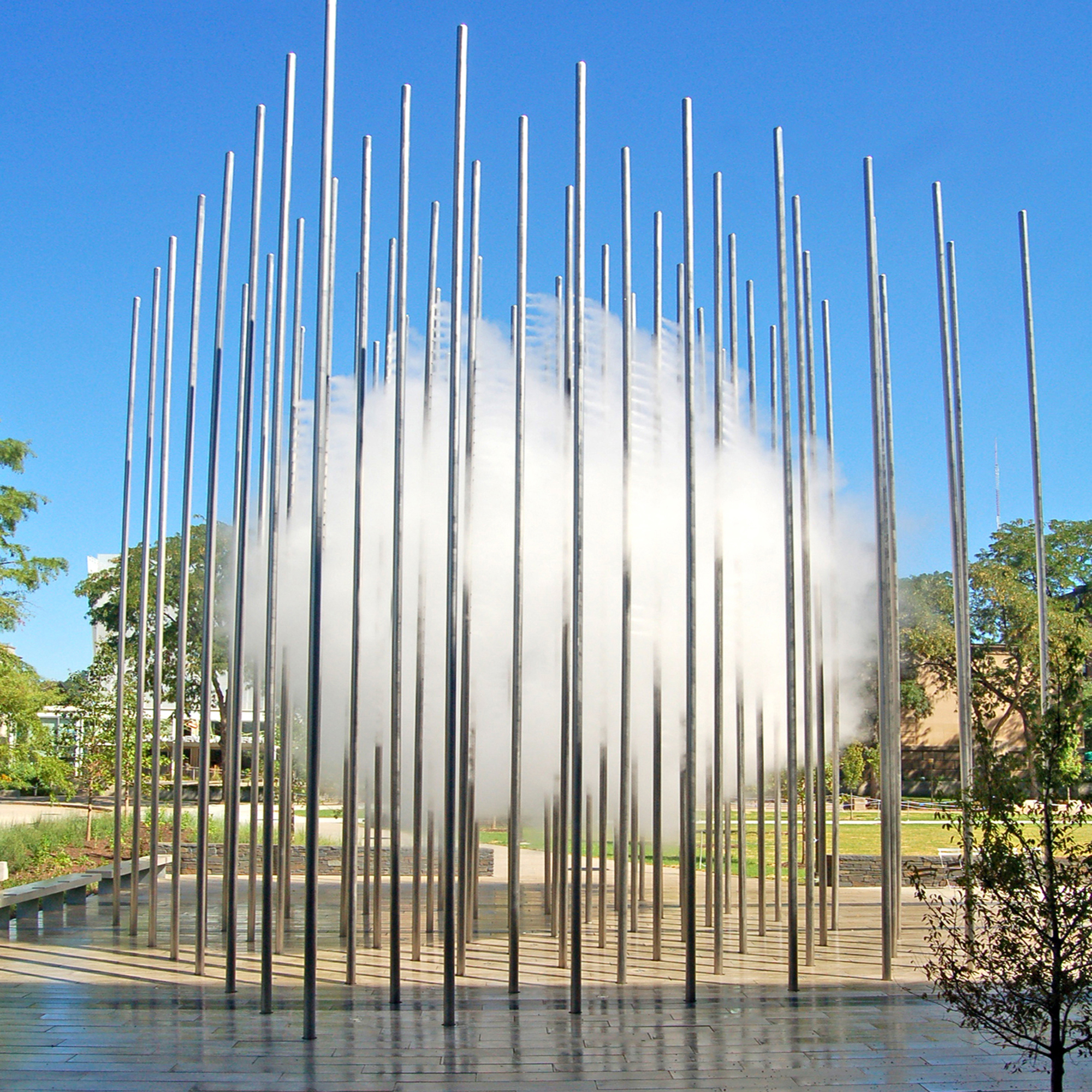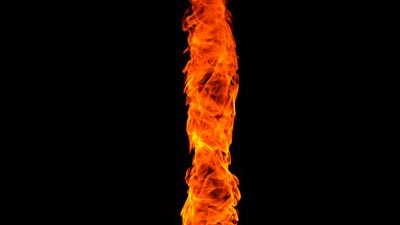Just like the exhibits at San Francisco’s Exploratorium that inspired Ned Kahn’s artwork, Kahn’s own work involves numerous scientific concepts and applications. Because Kahn’s work focuses on the scientific natural processes in the world, most, if not all of his displays require a basic understanding of related scientific concepts. For example, the creation of Kahn’s “Prism Tunnel” display in San Marino, California required some basic knowledge about light refraction.


Most people encounter light refraction at some point or another during their lifetime, whether in the form of Pink Floyd’s “The Dark Side of The Moon” album cover, or the rainbow that appears when light shines through a faceted piece of glass. Light refraction is simply the bending of light by a foreign medium, which changes the speed of the wave6. The most well known example of this phenomenon is the dispersion of white light into its constituent colors. Kahn uses a material called a diffraction grating in his “Prism Tunnel” sculpture in order to create a fascinating, ever-changing light display. The position and intensity of the light changes depending on the time of day during which it is observed.
Many of Ned Kahn’s other sculptures incorporate suspended fog or clouds, and I was curious about the process of their creation.

The sheer absurdity of a single cloud suspended among an artistic sculpture is fascinating, and the science behind it makes it exceptionally more interesting. In an entertainment review published in New Scientist, author Christine Ottery outlines the cloud-making process employed by a Dutch weather artist, Berndnaut Smilde7.

To create this transient work of art, Smilde mists water into the air, and releases a burst of chemical “fog” from a smoke machine into the mist. Simply put, the water droplets and smoke particles stick to each other, and a cloud forms. While seemingly simple in process, this art form is complex, and requires a substantial amount of patience and practice. Like most of the other “hard-to-manage phenomena”5 that Ned Kahn works with, the creation of artificial clouds is no exception in terms of difficulty. However, this difficulty and value of innovation and creative experimentation are key to the development of an intellectually interesting display that engages viewers to interact and explore. To say the least, difficulty and creative experimentation have played a pretty key role in the design and construction of my own creative sculpture.
Another one of Kahn’s sculptures that I found particularly fascinating is his “Fire Vortex” display.

Because this display functions so much like a tornado, I researched the characteristics of vortex flow structure and how they compare to the properties of a fire vortex. I came across a peer-reviewed journal article that discussed the results of a study, which examined this very relationship. The study involved the usage of velocity measurements to determine that the basic flow structure is identical among fire and tornado-like vortices7. Kahn’s “Fire Vortex” display is basically a tornado of fire! This insight into the physics of this particular display provoked my curiosity in the physical shapes and patterns formed by tornados and other “spiraling” natural phenomena (the formation of hurricanes, the shape of spiral galaxies, etc.). The extreme similarity between the shape of the spirals within these various phenomena led to my research of the mathematics behind this omnipresent spiral.
From this point on, I focused my following research on the mathematics of the Fibonacci sequence, its connection to fractal art and mathematics, and its ubiquitous presence in the natural world.
My research about fractals in general began with a course reading about fractal complexity, its presence in nature, and its application to the drip-painting art of American painter, Jackson Pollock9. This article describes a study conducted by four scientists, one of whom is Dr. Richard Taylor from the University of Oregon. The study concluded that the works of American painter, Jackson Pollock, display fractal patterns. Additionally, it explored the connection between the characteristics of fractals, and the long-term aesthetic appeal of Pollock’s splatter paintings.


Simply put, fractals are infinite patterns – mathematical phenomena that display a constantly repeating pattern on every scale. A major idea explored in this study is the concept that consistent mathematical patterns and ratios, such as fractals, exist within seemingly chaotic places. The complexity (also known as the “roughness”10) of such patterns can be quantified by their fractal dimension (signified by D). The value of D lies within the range of 1 and 2, where 1 displays no complexity, and 2 displays infinite complexity.
Taylor’s research, which he explained during our class visit to University of Oregon’s Camcor Lab12, found that Jackson Pollock’s early work (1943-1945) displayed values of around D = 1.10. Between 1945 and 1947, this value jumped to 1.7, and even later, he painted a piece with D = 1.89. Pollock immediately erased this most complex work, an re-stabilized his paintings at approximately D = 1.7. As noted in Taylor’s study, this suggests that Pollock’s years of refinement were “motivated by the desire to create fractal patterns with D approximately equal to 1.7.”9
Further investigation using eye-tracking and EEG measurements confirmed that humans visually prefer images in the range of D = 1.3, to D = 1.5. But WHY? Taylor’s article references another study, which suggests that this preference is a result of the complexity of our immediate environment. The fractals in nature that we most frequently experience are found in this same range of complexity!
This concept is extremely fascinating, and it directly relates to the idea that was provoked in my mind by Lisa Freinkel11 (another guest speaker): our perceptions are collectively shaped by perspective and awareness. Our visual preference for images in the range of D = 1.3 to D = 1.5 is based upon our perceptions of what we visualize. These perceptions are influenced by the mindsets we adopt when observing something (perspective), and how deeply we observe it (awareness).
Taylor extensively references the revolutionary work of mathematician Benoit Mandelbrot in his explanation of fractal concepts. This sparked my curiosity about his work, and led to the discovery of a TED Talk that Mandelbrot presented early in 201010. In this talk, Mandelbrot emphasizes the underlying concept that fractals are able find order within extreme chaos.
These fractals can be infinitely complex, yet can often be described with utmost simplicity. Using his own Mandelbrot Set to exemplify this, Mandelbrot displays an image of the Mandelbrot Set, accompanied by its extremely simple defining expression: z –> z2 + c. The paradoxical nature of fractals is absolutely intriguing: fractals are infinitely complex, yet can be described so simply.
“A fractal is a way of seeing infinity.” – Benoit Mandelbrot
During this course, I chose to direct my focus towards a single type of fractal pattern: the Fibonacci sequence. While applications of this mathematical sequence can be extremely complex, the sequence itself is very simple. As defined in Designa: Technical Secrets of the Traditional Visual Arts13, the Fibonacci sequence is a “cumulative progression where each number is the sum of the preceding two.” The sequence starts with 0 and 1, and theoretically, goes on forever.
The Fibonacci Sequence: {0, 1, 1, 2, 3, 5, 8, 13, 21, 34, 55, 89, 144, 233, 377, 610, 987, 1597, 2584………}


While its exact origin is not known, the Fibonacci sequence is believed to have been discovered by ancient Egyptians, and their Greek students. There is architectural evidence of this in the Great Egyptian Pyramids14 and in Greek architecture, such as the Parthenon15. Its discovery, however, is formally attributed to Leonardo of Pisa (Leonardo Pisano Bigollo), later named “Fibonacci” for short1. Fibonacci brought this number sequence to the world’s attention through his famous rabbit breeding problem. This problem, published in his book called Liber Abaci (“Book of Calculation”), showed how to determine the number of rabbit breeding pairs after a given number of generations13.
Fibonacci numbers were officially discovered by Leonardo of Pisa, but have existed in the universe for as long as we know. These numbers appear in nanoparticles13, black holes13, spiral galaxies16, flowers17, human anatomy13, and DNA nucleotides18. The list of examples of the Fibonacci sequence is essentially endless; these numbers even appear in pigeons 🙂

Often more relevant than the actual numbers in the sequence, is the phi (Φ) ratio13, which is equal to ≈1.618. This ratio is the relationship that exists between consecutive numbers in the Fibonacci sequence – each number is approximately 1.618 times the quantity of the previous number in the sequence. This phi ratio, also known as the “Golden Ratio” appears ubiquitously throughout the natural world, and in the art and architecture of various cultures.

The Fibonacci Spiral, which is my key aesthetic focus of this project, is a simple logarithmic spiral based upon Fibonacci numbers, and the golden ratio, Φ. Because this spiral is logarithmic, the curve appears the same at every scale, and can thus be considered fractal. As we have seen, numbers in the Fibonacci sequence have several ways of appearing in natural examples. The Fibonacci spiral, however, is a particularly fascinating application because of its mathematical perfection, aesthetic appeal, and biological importance.
One notable example of natural Fibonacci spiraling, is the arrangement of leaves, seeds, and petals in plants. For instance, the seeds in the center of a sunflower follow a perfect Fibonacci spiraling pattern, which allows for an efficient usage of space, and maximal seed packing. Looking at the leaf arrangement around the stem in many herbaceous plants (a study known as phyllotaxis13) reveals that the leaves are arranged in an identical spiraling pattern. In this case, the Fibonacci spiral benefits the plant by maximizing exposure of leaves to sunlight, and by aiding in even distribution of water17. From biological and evolutionary perspectives, the phi ratio and the Fibonacci spiral are essential to the structure, function, and survival of many organisms.


The Fibonacci sequence is fundamental to life on Earth, but goes much beyond our own world; the spiral that exists in the center of sunflowers, heads of cabbage, and chambered nautilus shells, is the same spiral that shapes spiral galaxies. The exact phi ratio that appears in the structure of the human body and in developing hurricanes, is the same ratio that occurs between the planetary orbits of Earth and Venus[1][13][16].

From all of these examples, it is not difficult to see that the Fibonacci sequence is EVERYWHERE. Its omnipresence in the universe is fascinating and extremely powerful: through a simple sequence of numbers and a related ratio, we share an inherent connection with all living beings, and the entirety of the universe. This is not only intriguing on a biological level, but also in a an intellectual and spiritual sense. We all seek answers about the universe and our place within it; the Fibonacci spiral has the power to both illustrate our relationship to others, and to give us a unique perspective about our place within the universe.
By delving into the deeply interconnected nature of the world, my intention is to illuminate the connections that humans share with their surroundings. In highlighting these connections, I hope to heighten both people’s awareness of the natural environment, and their concern about its well-being. In our environment’s critical state, it has never been more important for people to care about their own impact on the world.
Knowledge is powerful because it has the ability to elevate our own personal perceptions and environmental awareness. In this regard, my intention is to provide people with information, provoke their sense of curiosity and concern for the environment, and ultimately encourage collective motivation to take action.
One of Ned Kahn’s core intentions in creating his sculpture art, is to enliven peoples’ senses of curiosity about the world. This aspect of his artistic goal is one that we both share – provoking curiosity is not only an intellectual and artistic goal that I aspire to achieve, for it is also the first step in taking action. Curiosity is a crucial first step in the direction of action.
In addition to emphasizing my goal of provoking curiosity, Ned Kahn’s work has effectively inspired me to focus on generating environmental awareness via my creative display. Also, while I originally considered different 2-dimensional media for my artistic display, I decided to create a 3-dimensional sculpture in order to emulate Ned Kahn’s style. I didn’t have much previous experience with 3D media, so this form of creative expression was definitely a new one!